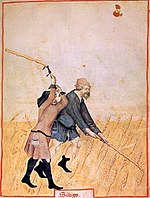Portal:Middle Ages/Selected article/1
Medieval cuisine includes the foods, eating habits, and cooking methods of various European cultures during the Middle Ages, a period roughly dating from the 5th to the 16th century. During this period, diets and cooking changed across Europe, and these changes helped lay the foundations for modern European cuisine.Bread was the staple, followed by other foods made from cereals, such as porridge and pasta. Meat was more prestigious and more expensive than grain or vegetables. Common seasonings included verjuice, wine and vinegar. These, along with the widespread use of honey or sugar (among those who could afford it), gave many dishes a sweet-sour flavor. The most popular types of meat were pork and chicken, while beef, which required greater investment in land, was less common. Cod and herring were mainstays among the northern population, but a wide variety of other saltwater and freshwater fish were also eaten. Almonds, both sweet and bitter, were eaten whole as garnish, or more commonly ground up and used as a thickener in soups, stews, and sauces. Particularly popular was almond milk, which was a common substitute for animal milk as a cooking medium during Lent and fasts.Slow transportation and inefficient food preservation techniques prevented long-distance trade of many foods.

